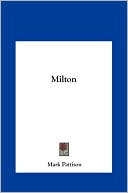

 |

|

The average rating for Milton based on 2 reviews is 4.5 stars.
Review # 1 was written on 2013-08-10 00:00:00 Andrew Masenas Andrew MasenasA good biography of a feisty, talented, independent as well as needy, emotionally volcanic and yet very intellectual woman…interesting, and historically important. |
Review # 2 was written on 2012-04-24 00:00:00 Sean Mckiernan Sean MckiernanWhat a great read! Mary Wollstonecraft was truly an amazing, independent woman during the 1790s. Her childhood family situation was horrible --poverty brought on by her father (an abusive drunk who stole all their money for his excursions). At an early age, Mary fought against the injustices she saw around her (shielding her mother with her body as her drunken father beat her mother.) By the time she reached adulthood, she had rejected the typical role for women in the 18th century, especially where conventional marriage was concerned; she also believed there was more to life than teaching or being a governess which were the acceptable occupations for women. Early she accepted a job as a lady's companion to widow Sarah Dawson in Bath. Mary had trouble getting along with her. In 1780 she returned home, to care for her dying mother. After her death, Mary moved in with her closest friend, Fanny Blood and family. Mary envisioned living in a female utopia with Fanny; they made plans to rent rooms together and support each other emotionally and financially, but this dream collapsed under economic realities. In order to make a living, Mary, her sisters, and Fanny set up a school together. But Fanny became engaged and after their marriage went to Europe to improve her health, but health deteriorated when she became pregnant, and in 1785 Mary left the school to nurse Fanny, but she died. Her death devastated Mary and it inspired her first novel, Mary: A Fiction (1788). Mary became a governess to Kingsborough family in Ireland but after a year she decided to become an author. Mary left for London to establish herself as a writer with publisher Joseph Johnson. She found a place to live, work and took on the responsibility of monetarily supporting her siblings and parents. Despite that fact that her two sisters, Everina and Eliza resented her. She became "enraptured by Fuseli's genius" and proposed a platonic living arrangement with him & his wife but he broke off the relationship which devastated her. Mary decided to travel to France to escape the humiliation of the incident, and to participate in the revolutionary events. She had just celebrated her "Vindication of the Rights of Men" (1790) which made her famous overnight. She pursued the ideas she had outlined in that book in "A Vindication of the Rights of Woman" (1792), her most famous and influential work. Mary left for France to write a book on the French Revolution (which if discovered would have cost her life.) On Jan. 21, 1793 Louis XVI was guillotined. Despite the terror, Mary falls in love with a deceptive, shallow American Gilbert Imlay and conceives a child. Britain declares war on France, placing all British subjects in France in danger. To protect Mary, Imlay registered her as his wife in 1793, even though they were not married. Some of her friends were not so lucky; many, like Thomas Paine, were arrested, and some were even guillotined. She is devasted by the lies told by her lover, gives birth to a daughter, Fanny (after her dear friend), and returns to England where she tires to commit suicide (Lauganum) unsuccessfully. Imlay convinces her to embark some business negotiations for him in Scandinavia, trying to recoup some of his losses. Wollstonecraft undertook this hazardous trip with only her young daughter and a maid. She recounted her travels and thoughts in letters to Imlay, many of which were eventually published as Letters Written During a Short Residence in Sweden, Norway, and Denmark in 1796. And he promise to meet her and make a decision on their arrangement, which of course disappointed her. Backin England she attempts a second suicide attempt (drowning in the Thames River) but was rescued by a stranger. She returned to her literary life, with dear friend Joseph Johnson and friends and meets William Godwin with whom she develops a passionate love affair. Godwin had read her Letters Written in Sweden, Norway, and Denmark and later wrote that "If ever there was a book calculated to make a man in love with its author, this appears to me to be the book. She speaks of her sorrows, in a way that fills us with melancholy, and dissolves us in tenderness, at the same time that she displays a genius which commands all our admiration." She becomes pregnant and they married on March 29, 1797 and moved into two adjoining houses, known as The Polygon, so that they could both still retain their independence; they often communicated by letter. On 30 August 1797, Wollstonecraft gave birth to her second daughter, Mary. Although the delivery seemed to go well initially, the placenta broke apart during the birth and became infected; puerperal (childbed) fever was a common and often fatal occurrence in the eighteenth century. After several days of agony, Wollstonecraft died of septicaemia on 10 September. Godwin was devastated: he wrote to his friend Thomas Holcroft, "I firmly believe there does not exist her equal in the world. I know from experience we were formed to make each other happy. I have not the least expectation that I can now ever know happiness again." |
CAN'T FIND WHAT YOU'RE LOOKING FOR? CLICK HERE!!!